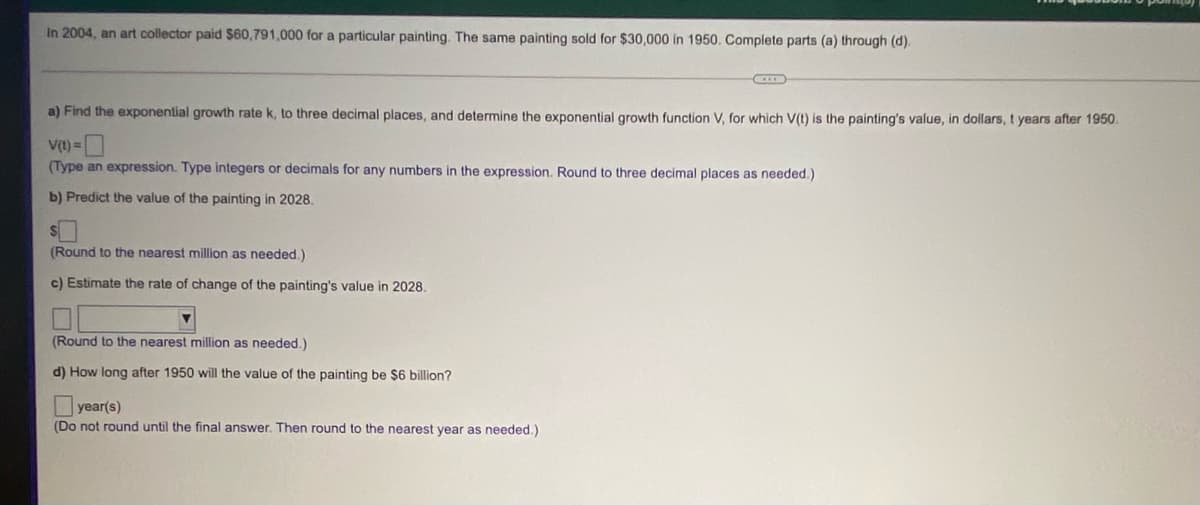In 2004, an art collector paid $60,791,000 for a particular painting. The same painting sold for $30,000 in 1950. Complete parts (a) through (d). a) Find the exponential growth rate k, to three decimal places, and determine the exponential growth function V, for which V(t) is the painting's value, in dollars, t years after 1950. V(1) = (Type an expression. Type integers or decimals for any numbers in the expression. Round to three decimal places as needed.) b) Predict the value of the painting in 2028. (Round to the nearest million as needed.) c) Estimate the rate of change of the painting's value in 2028. (Round to the nearest million as needed.)
In 2004, an art collector paid $60,791,000 for a particular painting. The same painting sold for $30,000 in 1950. Complete parts (a) through (d). a) Find the exponential growth rate k, to three decimal places, and determine the exponential growth function V, for which V(t) is the painting's value, in dollars, t years after 1950. V(1) = (Type an expression. Type integers or decimals for any numbers in the expression. Round to three decimal places as needed.) b) Predict the value of the painting in 2028. (Round to the nearest million as needed.) c) Estimate the rate of change of the painting's value in 2028. (Round to the nearest million as needed.)
Glencoe Algebra 1, Student Edition, 9780079039897, 0079039898, 2018
18th Edition
ISBN:9780079039897
Author:Carter
Publisher:Carter
Chapter7: Exponents And Exponential Functions
Section7.8: Transforming Exponential Expressions
Problem 1CYU
Related questions
Question
18

Transcribed Image Text:In 2004, an art collector paid $60,791,000 for a particular painting. The same painting sold for $30,000 in 1950. Complete parts (a) through (d).
a) Find the exponential growth rate k, to three decimal places, and determine the exponential growth function V, for which V(t) is the painting's value, in dollars, t years after 1950.
v(1) =
(Type an expression. Type integers or decimals for any numbers in the expression. Round to three decimal places as needed.)
b) Predict the value of the painting in 2028.
(Round to the nearest million as needed.)
c) Estimate the rate of change of the painting's value in 2028.
(Round to the nearest million as needed.)
d) How long after 1950 will the value of the painting be $6 billion?
year(s)
(Do not round until the final answer. Then round to the nearest year as needed.)
Expert Solution
This question has been solved!
Explore an expertly crafted, step-by-step solution for a thorough understanding of key concepts.
This is a popular solution!
Trending now
This is a popular solution!
Step by step
Solved in 4 steps with 5 images

Recommended textbooks for you

Glencoe Algebra 1, Student Edition, 9780079039897…
Algebra
ISBN:
9780079039897
Author:
Carter
Publisher:
McGraw Hill

Algebra & Trigonometry with Analytic Geometry
Algebra
ISBN:
9781133382119
Author:
Swokowski
Publisher:
Cengage

College Algebra (MindTap Course List)
Algebra
ISBN:
9781305652231
Author:
R. David Gustafson, Jeff Hughes
Publisher:
Cengage Learning

Glencoe Algebra 1, Student Edition, 9780079039897…
Algebra
ISBN:
9780079039897
Author:
Carter
Publisher:
McGraw Hill

Algebra & Trigonometry with Analytic Geometry
Algebra
ISBN:
9781133382119
Author:
Swokowski
Publisher:
Cengage

College Algebra (MindTap Course List)
Algebra
ISBN:
9781305652231
Author:
R. David Gustafson, Jeff Hughes
Publisher:
Cengage Learning

Big Ideas Math A Bridge To Success Algebra 1: Stu…
Algebra
ISBN:
9781680331141
Author:
HOUGHTON MIFFLIN HARCOURT
Publisher:
Houghton Mifflin Harcourt


College Algebra
Algebra
ISBN:
9781305115545
Author:
James Stewart, Lothar Redlin, Saleem Watson
Publisher:
Cengage Learning